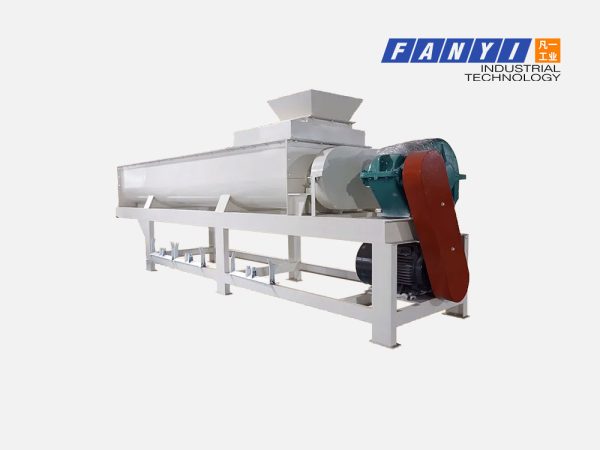Address
No. 128, Binhe Road, Gongyi City
Zhengzhou City, Henan Province, China, 451200
Contact us
Phone: (+86) 13386837400
WhatsApp/WeChat: (+86) 13386837400
Address
No. 128, Binhe Road, Gongyi City
Zhengzhou City, Henan Province, China, 451200
Contact us
Phone: (+86) 13386837400
WhatsApp/WeChat: (+86) 13386837400






Paddle mixer also named as double shaft mixer or twin shaft mixer, is a kind of continuous blender which mixes, kneads and moistens the mixture to optimize the blending and disintegrating effect.
The forward and reverse alternating screw paddles are used to make the materials advance alternately in the ω-shaped mixing tank, which has the characteristics of strong mixing ability and uniform feeding. It is suitable for mixing and humidification of loose materials, such as coal humidity control, and can also be used as a pretreatment equipment before intensive mixing.
Double-shaft mixer uses the synchronous rotation of two screw shafts to convey materials, and at the same time add water to mix, to achieve uniform humidification of materials and reduce dust. The humidified and mixed materials are easy to load and transport or transfer to the next processing equipment. It is mainly suitable for the humidification of coal, slag, and other similar materials in thermal power plants, mines, and other industries.

A pair of mixing shafts is intalled in the mixing tank, which are the active mixing shaft and the passive mixing shaft. The two ends of the mixing shafts are supported by the front and rear bearing seats, and the two ends of the mixing tank are respectively sealed by the sealing seat.
Mixing paddles are installed on the shaft according to the direction of screw propulsion, and the rotation directions of the two shafts are opposite. When the material is rotated by the mixing paddle, it is mixed and moved forward. The uniformity and residence time of the material mixing mainly depend on the angle between the paddles and the shaft and the rotation speed of the shaft.
The material is fed from the top of one end of the mixer. When the two horizontal shafts rotate, because the paddle is installed at a certain angle, the paddle on the shaft rotates in a screw shape, pushing the material forward along the shaft, and the shafts rotate together to drive the stirring and pushing of the paddles. Rolling up and down and moving left and right by extrusion, the material is gradually mixed evenly, and moves to the discharge end, and finally discharges at the lower opening at the other end.
Equipment equipped with the liquid adding device will add liquid when the material enters the mixing chamber, and fully wet and mix it during the mixing process.

The mixing is transmitted from the transmission wheel to the main shaft through the pin coupling. The special shaft mixing paddles welded or equipped on the main shaft rotates synchronously, turning the material evenly in the mixing tank, making the material fully mixed. Thus greatly reducing the residual amount of the material.
The transmission is driven by the motor to drive the pulley, V-belt, reducer, etc. to make the main shaft rotate. The reducer and the working section of the main engine are made of nylon pins as the transmission joint, and are driven by the transmission mechanism, which is convenient for assembly and maintenance.
The force from the gear motor through the coupling is transmitted to the cylindrical gearbox, which transmits rotation to the mixer shafts. The drive system allows you to compensate for possible misalignment of the shafts due to installation errors, under shock, vibration and dynamic loads, guarantees high torque on the mixer shaft and overall reliability of the equipment.
All working parts of the machine are installed and fixed on the frame, and the frame is welded with thick steel plate and channel steel.

1. Transmission part 2. Feeding port 3. Paddle 4. Mixing tank 5. Twin shaft 6. Frame
Mixing and blending: FGD scrubber sludge, fly ash, and lime for SO2 neutralization, municipal sludge for composting facilities, pigments and dyes, and other processes combining moist and dry feed materials, gangue, shale, tailings, construction waste, clay and fly ash mixing for clay and tile making.
Agglomeration and dedusting: Granulation of agricultural chemicals, fertilizers, chemical consumer products, carbon powders, flue dust from dust collectors in power plants, animal feed, cement pelletizing pre-agglomeration, etc.
Material conditioning: Fly ash, cement or lime kiln dust, foundry dust, iron oxide, friction material waste, lead fume, zinc oxide, copper reverts and concentrates.
 |
 |
 |
 |
| Heavy duty | Wear-resistant surfacing paddle | Double shaft transmission | Pug sealer |
| Model | Capacity | Groove length | Paddle rotating diameter | Power |
| 350 | 10-15 t/h | 2000 mm | 350 mm | 7.5 kW |
| 400 | 20-40 t/h | 2500 mm | 400 mm | 11 kW |
| 500 | 20-50 t/h | 2500 mm | 500 mm | 18.5 kW |
| 600 | 30-80 t/h | 3000 mm | 600 mm | 22 kW |
| 700 | 40-100 t/h | 3000 mm | 700 mm | 30 kW |
| 1000 | 120-200 t/h | 3000 mm | 1000 mm | 45 kW |
To handle complex conveying situations, the Twin Screw Mixer is available in a variety of different designs, such as:
You must be logged in to post a review.
Reviews
There are no reviews yet.